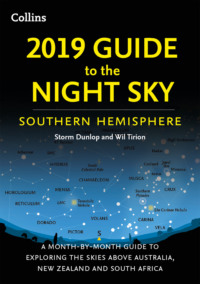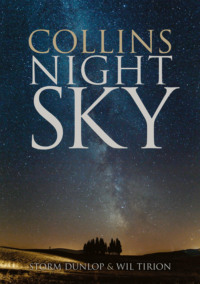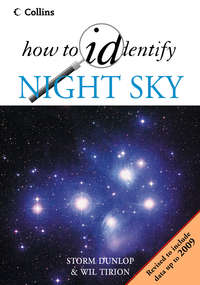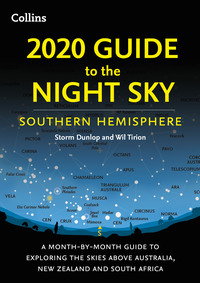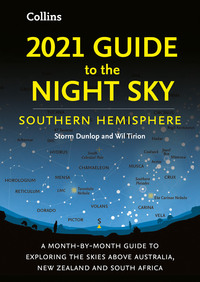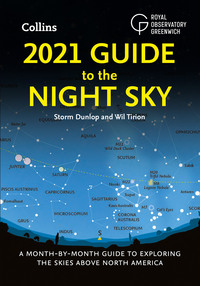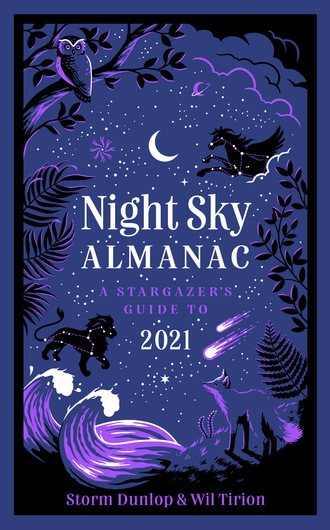
Полная версия
Night Sky Almanac 2021

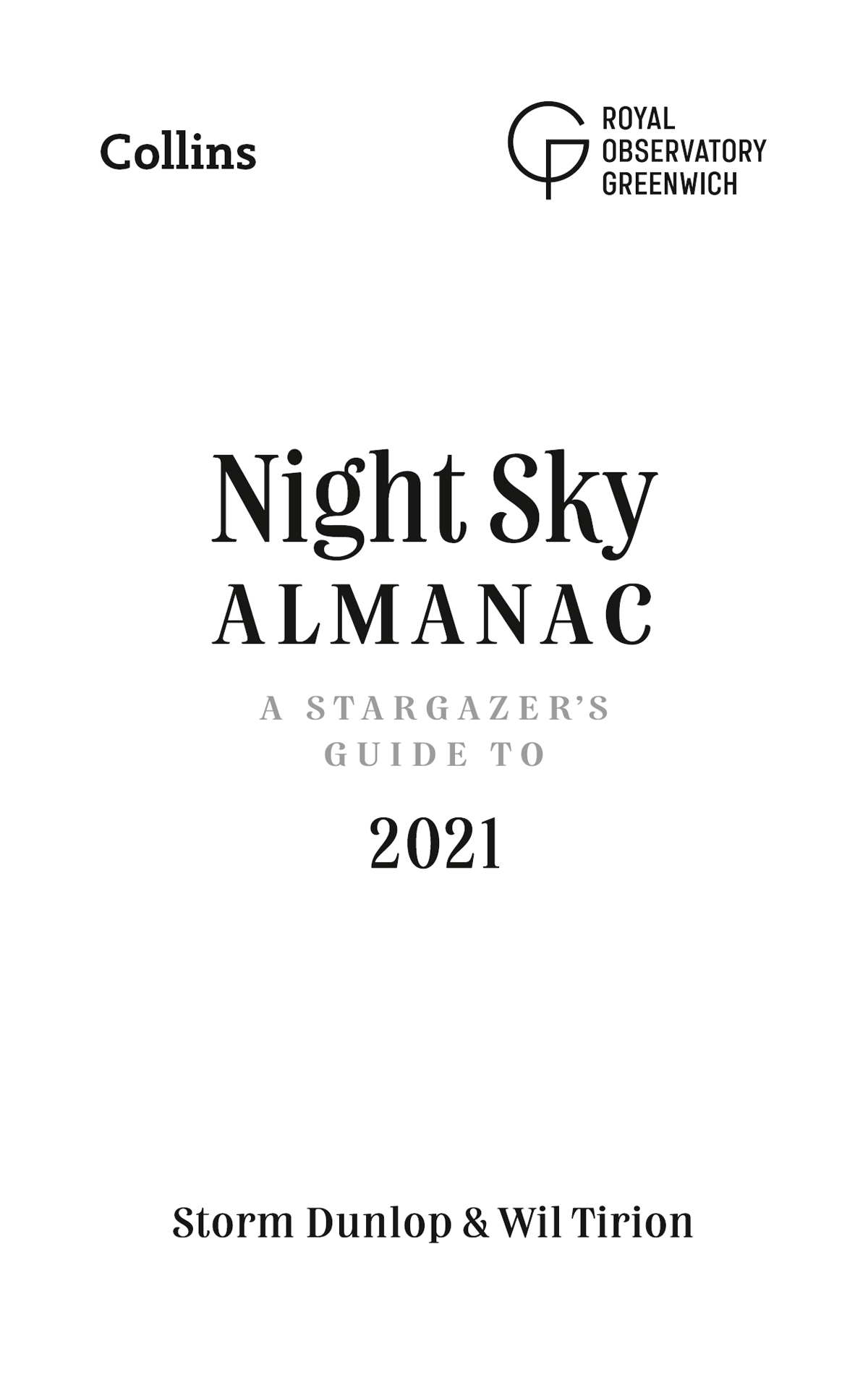
Copyright
Published by Collins
An imprint of HarperCollins Publishers
Westerhill Road
Bishopbriggs
Glasgow G64 2QT
www.harpercollins.co.uk
In association with
Royal Museums Greenwich, the group name for the National Maritime Museum,
Royal Observatory Greenwich, Queen’s House and Cutty Sark
www.rmg.co.uk
© HarperCollins Publishers 2020
Text and illustrations © Storm Dunlop and Wil Tirion
Cover illustrations © Julia Murray
Images and illustrations see acknowledgements here
Collins ® is a registered trademark of HarperCollins Publishers Ltd
All rights reserved under International and Pan-American Copyright Conventions. By payment of the required fees, you have been granted the non-exclusive, non-transferable right to access and read the text of this e-book on screen. No part of this text may be reproduced, transmitted, downloaded, decompiled, reverse engineered, or stored in or introduced into any information storage and retrieval system, in any form or by any means, whether electronic or mechanical, now known or hereafter invented, without the express written permission of HarperCollins.
The contents of this publication are believed correct at the time of printing. Nevertheless the publisher can accept no responsibility for errors or omissions, changes in the detail given or for any expense or loss thereby caused.
HarperCollins does not warrant that any website mentioned in this title will be provided uninterrupted, that any website will be error free, that defects will be corrected, or that the website or the server that makes it available are free of viruses or bugs. For full terms and conditions please refer to the site terms provided on the website.
A catalogue record for this book is available from the British Library
eBook Edition © October 2020
ISBN 9780008403614
Version: 2020-09-11
Contents
Cover
Title Page
Copyright
Foreword
Introduction
Some Interesting Objects
Major Events in 2021
The Moon
Map of the Moon
The Circumpolar Constellations
The Monthly Maps
World Map
January
February
March
April
May
June
July
August
September
October
November
December
Dark Sky Sites
Twilight Diagrams
Glossary and Tables
Searchable Terms
Acknowledgements
About the Publisher
Foreword
For thousands of generations, your ancestors have marvelled at the night sky above them. They pondered its meaning and distance, tracing patterns and telling stories with the stars; they watched with great interest as the Moon and a handful of bright, wandering lights traversed the sky independently; sometimes they looked on in awe as a new visitor drifted above, with a long tail in tow; at other times they stayed up, alert, as stars appeared to streak across the sky with alarming speed; perhaps they cowered in fear when, on rare occasions, the Moon turned blood red or challenged the daylight by taking a bite from the Sun.
Gradually, superstition gave way to understanding. Comprehension of the night sky’s cyclical nature proved foundational to an inevitable agricultural revolution, which propelled the progress of civilisation forward, forever cementing astronomy’s influence on our lives. The stars have also permeated into our wider cultural heritage, appearing in religious texts and great works of art – visual, poetic and musical. The Moon, our unfailing celestial companion, altered the course of life on Earth through its mastery of the tides, and has since become a frontier of exploration for our species – a stepping stone towards our spacefaring future. It is remarkable how far we have come since humans first turned their attention to the stars over 50,000 years ago.
Today, our lives are very different from theirs, but the curiosity driving the earliest stargazers has not left us. It has only become muffled by the increasing intrusion of artificial light pollution that has brightened our skies. The stars, planets and Moon still play overhead as they always have, and each year many annual meteor showers and other events go underappreciated as fewer of us enjoy regular access to the night sky. Yet, with only a little guidance you can rekindle this deeply ingrained fascination and, armed with the extensive knowledge of the modern astronomical age, explore the universe we call home.
This Almanac invites you to reconnect with your ancestral stargazing roots, by following the progress of the constellations throughout the seasons. With the aid of its monthly calendars and maps, you will chart the rhythm of the lunar phases, discover events that light up the sky for brief periods, and explore the rich tapestry of characters that adorn the starry canvas overhead. You can delve as deeply as you like, or follow your own favourite subject throughout the year. The treasures of the night sky will be waiting for you.
Tom Kerss
Introduction
The aim of this book is to help people to find their way around the night sky and to understand what is visible every month, from anywhere in the world. The stars that may be seen depend on where you are on Earth, but even if you travel widely, this book will show you what you can see. The night sky also changes from month to month and these changes, together with some of the significant events that occur during the year are described and illustrated.
The charts that are used differ considerably from those found in most astronomy books, and have been specifically designed for use anywhere in the world. A full description of how to use and understand the monthly charts is given here to here.
Sunrise, sunset and twilight
The conditions for observing naturally vary over the course of the year and one’s location on Earth. Sunrise and sunset vary considerably, depending in particular on one’s latitude. Sunrise and sunset times are given each month for nine different locations around the world. These places are shown in a bold typeface on the world map here and here. Sunrise and sunset times are given for the first and last days in every month, for these specific locations. Another factor that influences what may be seen is twilight at dusk and dawn. Again, this varies considerably with one’s latitude on Earth. The diagrams here to here show how this varies for the nine locations, which have been chosen to show the range of variation, rather than just for the importance of the places that have been included. The different stages of twilight and how they affect observing are also explained there.
Moonlight
Yet another factor that affects the visibility of objects is the amount of moonlight in the sky. At Full Moon, it may be very difficult to see some of the fainter stars and objects, and even when the Moon is at a smaller phase it seriously interferes with visibility if it is near the stars or planets in which you are interested. A full lunar calendar is given for each month and may be used to see when nights are likely to be darkest and best for observing.
The celestial sphere
All the objects in the sky (including the Sun, Moon, and stars) appear to lie at some indeterminate distance on a large sphere, centred on the Earth. This celestial sphere has various reference points and features that are related to those of the Earth. If the Earth’s rotational axis is extended, for example, it points to the North and South Celestial Poles, which are thus in line with the North and South Poles on Earth. As shown in the diagrams, the altitude of the celestial pole is equal to the observer’s latitude, whether in the north or south. Similarly, the celestial equator lies in the same plane as the Earth’s equator, and divides the sky into northern and southern hemispheres.
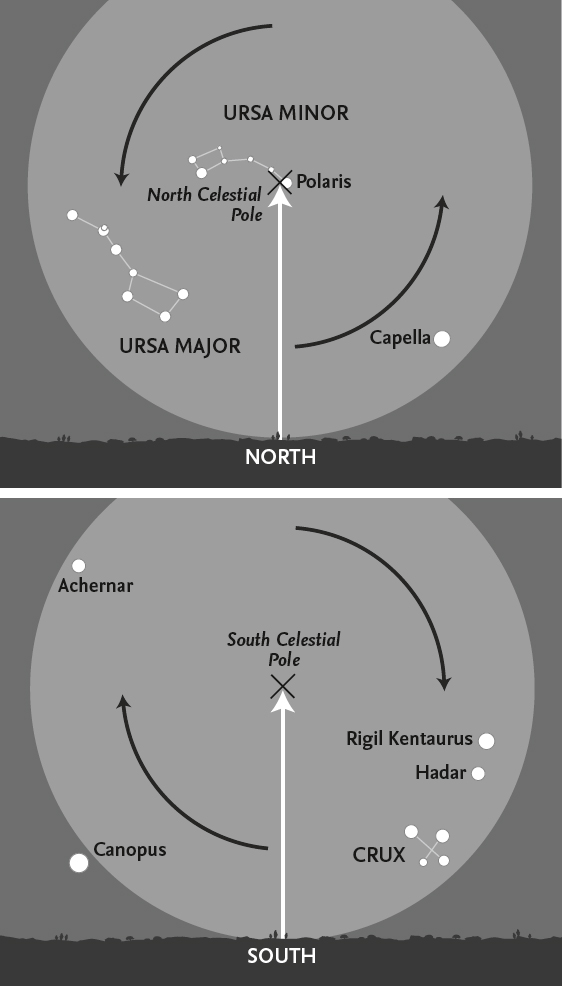
The altitude of the Celestial Pole equals the observer’s latitude.
It is useful to know some of the special terms for various parts of the sky. As seen by an observer, half of the celestial sphere is invisible, below the horizon. The point directly overhead is known as the zenith, and this point is shown on the monthly charts for several different latitudes, where it is an important reference point. The (invisible) point below one’s feet is the nadir. The line running from the north point on the horizon, up through the zenith and then down to the south point is the meridian. This is an important invisible line in the sky, because objects are highest in the sky, and thus easiest to see, when they cross the meridian in the south. Objects are said to transit, when they cross this line in the sky.
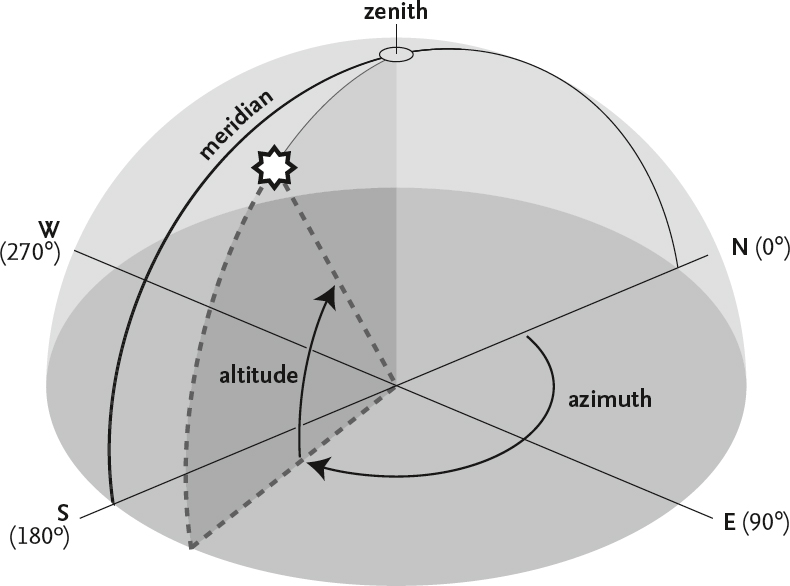
Measuring altitude and azimuth on the celestial sphere.
In this book, reference is sometimes made in the text and in the diagrams to the standard compass points around the horizon. The position of any object in the sky may be described by its altitude (measured in degrees above the horizon) and its azimuth (measured in degrees from north, 0°, through east, 90°, south, 180°, and west, 270°). Experienced amateurs and professional astronomers also use another system of specifying locations on the celestial sphere, but that need not concern us here, where the simpler method will suffice.
The celestial sphere appears to rotate about an invisible axis, running between the north and south celestial poles. The location (i.e., the altitude) of the celestial poles depends entirely on the observer’s position on Earth or, more specifically, their latitude.
The ecliptic and the zodiac
Another important line on the celestial sphere is the Sun’s apparent path against the background stars – in reality the result of the Earth’s orbit around the Sun. This is known as the ecliptic. The point where the Sun, apparently moving along the ecliptic, crosses the celestial equator from south to north is known as the vernal (or northern spring) equinox, which occurs around March 21. At this time (and at the northern autumnal equinox, on September 22 or 23, when the Sun crosses the celestial equator from north to south) day and night are almost exactly equal in length. (There is a slight difference, but that need not concern us here.) The vernal equinox is currently located in the constellation of Pisces, and is important in astronomy because it defines the zero point for a system of celestial coordinates, which is, however, not used in this book.
The Moon and planets are to be found in a band of sky that extends 8° on either side of the ecliptic. This is because the orbits of the Moon and planets are inclined at various angles to the ecliptic (i.e., to the plane of the Earth’s orbit). This band of sky is known as the zodiac, and when originally devised, consisted of twelve constellations, all of which were considered to be exactly 30° wide. When the constellation boundaries were formally established by the International Astronomical Union in 1930, the exact extent of most constellations was altered, and nowadays, the ecliptic passes through thirteen constellations. Because of the boundary changes, the Moon and planets may actually pass through several other constellations that are adjacent to the original twelve.
The smallest constellation is Crux. It covers an area of just 68 square degrees.
The constellations
In the western astronomical tradition, the celestial sphere has always been divided into various constellations, most dating back to antiquity and usually associated with certain myths or legendary people and animals. Nowadays, 88 constellations cover the whole sky, and their boundaries have been fixed by international agreement. Their names (in Latin) are largely derived from Greek or Roman originals. (A full list of the constellations is given here to here, with their names in English, their abbreviations, and genitive forms.) Some of the names of the most prominent stars are of Greek or Roman origin, but many are derived from Arabic names. Some bright stars have no individual names, and for many years, they were identified by terms such as ‘the star in Hercules’ right foot’. A more sensible scheme was introduced by the German astronomer Johannes Bayer in the early seventeenth century. Following his scheme – which is still used today – most of the brightest stars are identified by a Greek letter followed by the genitive form of the constellation’s Latin name. An example is the Pole Star, also known as Polaris and α Ursae Minoris. The Greek alphabet is shown here.
The largest constellation is Hydra. It covers an area of 1303 square degrees, and more than 7 hours of Right Ascension (105°).
Asterisms
Apart from the constellations, certain groups of stars, which may form a small part of a larger constellation, are readily recognizable and have been given individual names. These groups are known as asterisms, and the most famous (and well-known) is the ‘Plough’ or ‘Big Dipper’, the common name for the seven brightest stars in the constellation of Ursa Major, the Great Bear. The names and identifications of some popular asterisms are given in the list here.
The Moon
As it passes across the sky from west to east in its orbit around the Earth, the Moon moves by approximately its diameter (about half a degree) in an hour. Normally, in its orbit, the Moon passes above or below the direct line between Earth and Sun (at New Moon) or outside the area obscured by the Earth’s shadow (at Full Moon). Occasionally, however, the three bodies are more-or-less perfectly aligned to give an eclipse: a solar eclipse at New Moon, or a lunar eclipse at Full Moon. Depending on the exact circumstances, a solar eclipse may be merely partial (when the Moon does not cover the whole of the Sun’s disc); annular (when the Moon is too far from Earth in its orbit to appear large enough to hide the whole of the Sun); or total. Total and annular eclipses are visible from very restricted areas of the Earth, but partial eclipses are normally visible over a wider area. Two forms of solar eclipse occur this year, and are described in detail in the appropriate month.
Precautions must always be taken when viewing even partial phases of a solar eclipse to avoid damage to your eyes. Only ever use proper eclipse glasses, or a proper solar filter over the full objective of a telescope. The glass ‘solar filters’ sometimes provided with cheap telescopes should never be used. They are unsafe.
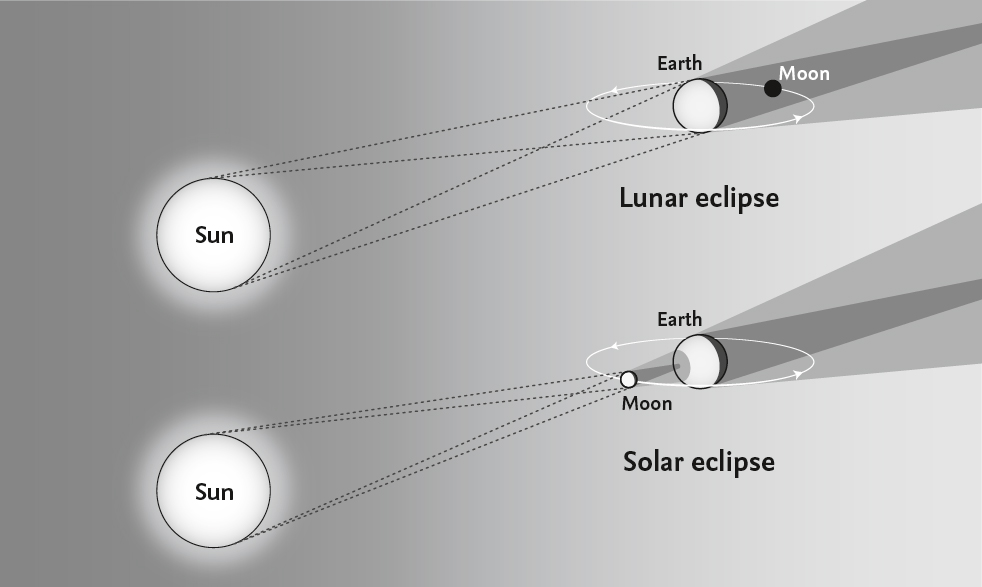
When the Moon passes through the Earth’s shadow (top), a lunar eclipse occurs. When it passes in front of the Sun (below) a solar eclipse occurs.
Somewhat similarly, at a lunar eclipse, the Moon may pass through the outer zone of the Earth’s shadow, the penumbra (in a penumbral eclipse, which is not generally perceptible to the naked eye); pass so that just part of the Moon is within the darkest part of the Earth’s shadow, the umbra (in a partial eclipse); or completely within the umbra (in a total eclipse). Unlike solar eclipses, lunar eclipses are visible from large areas of the Earth. Again, these are described in detail in the relevant month.
Occasionally, as it moves across the sky, the Moon passes between the Earth and individual planets or distant stars, giving rise to an occultation. As with solar eclipses, such occultations are visible from restricted areas of the world, but certain significant occultations are described in detail.
The Planets
Because the planets are always moving against the background stars, they are treated in some detail in the monthly pages and information is given when they are close to other planets, the Moon, or any of five bright stars that lie near the ecliptic. Such events are known as appulses or, more frequently, as conjunctions. (There are technical differences in the way these terms are defined – and should be used – in astronomy, but these need not concern us here.) The term conjunction is also used when a planet is either directly behind or in front of the Sun, as seen from Earth. (Under normal circumstances it will then be invisible.) The conditions of most favourable visibility depend on whether the planet is one of the two known as inferior planets (Mercury and Venus) or one of the three superior planets (Mars, Jupiter and Saturn) that are covered in detail. Brief details of the fainter superior planets, Uranus and Neptune, are given, especially when they come to opposition.
The inferior planets are most readily seen at eastern or western elongation, when their angular distance from the Sun is greatest. For superior planets and minor planets, they are best seen at opposition, when they are directly opposite the Sun in the sky, and cross the meridian at local midnight.
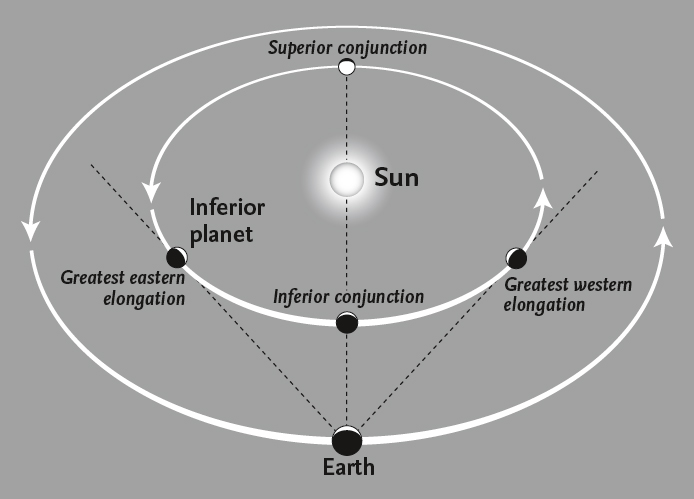
Inferior planet.
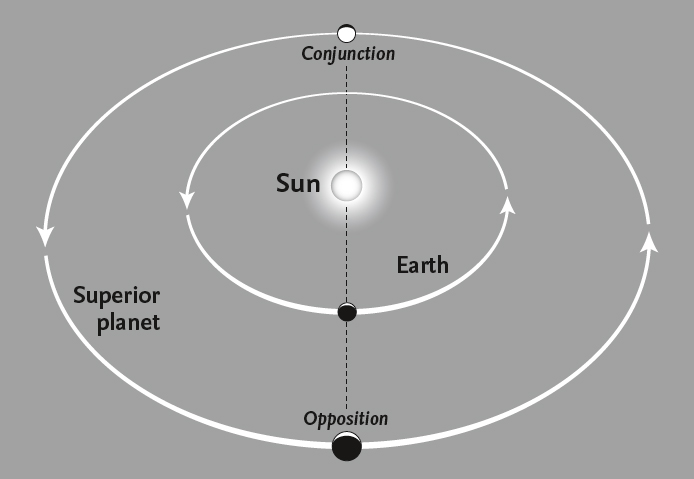
Superior planet.
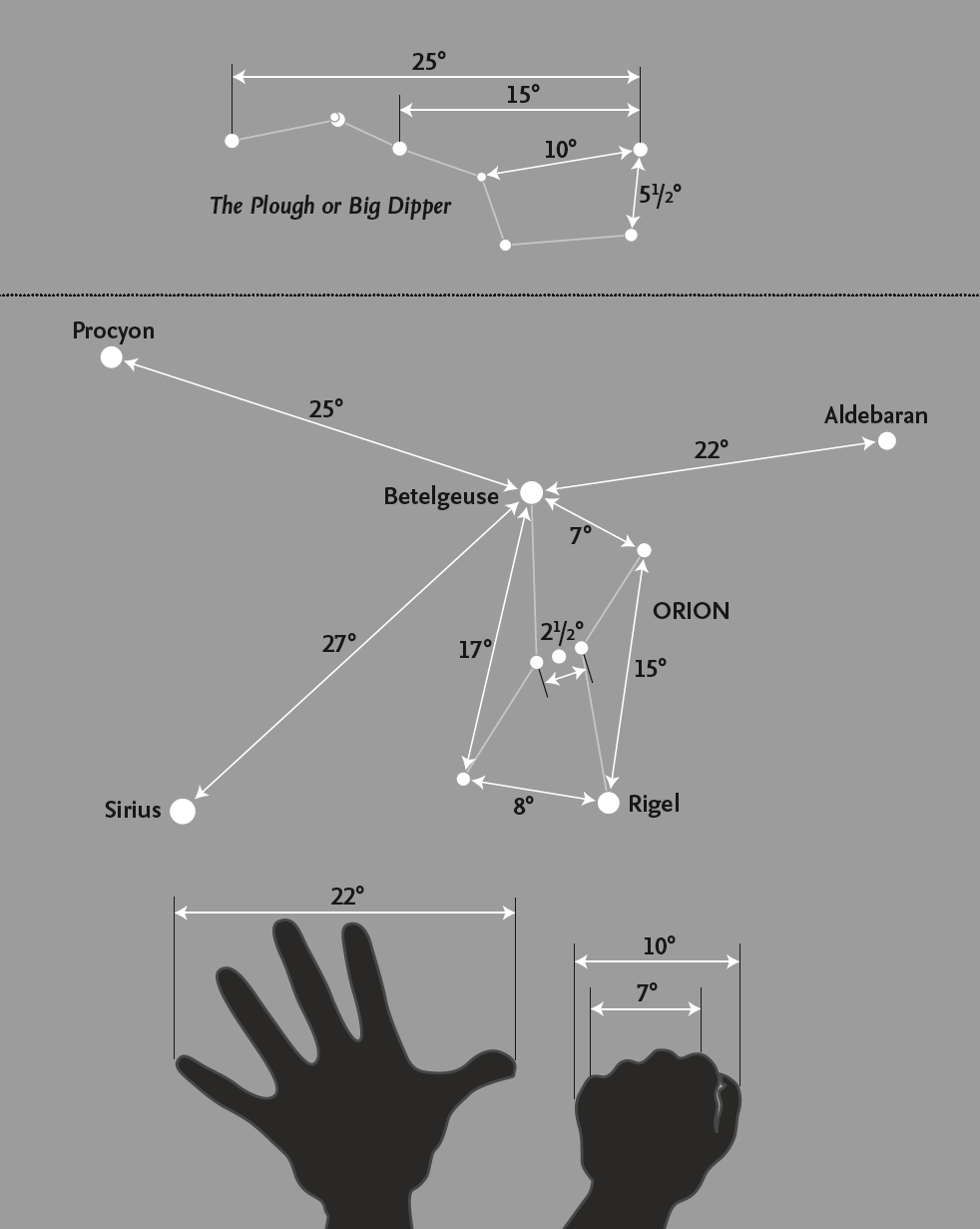
Measuring angles in the sky.
It is often useful to be able to estimate angles on the sky, and approximate values may be obtained by holding one hand at arm’s length. The various angles are shown in the diagram, together with the separations of the various stars in the asterism, known as the Plough or Big Dipper, and also for stars around the constellation of Orion.
Events
A number of interesting events are shown in diagrams for each month. They involve the planets and the Moon, sometimes showing them in relation to specific stars. Events have been chosen as they will appear from one of three different locations: from London; from the central region of the USA; or from Sydney in Australia. Naturally, these events are visible from other locations, but the appearance of the objects on the sky will differ slightly from the diagrams. A list of major astronomical events in 2021 is given here and here.
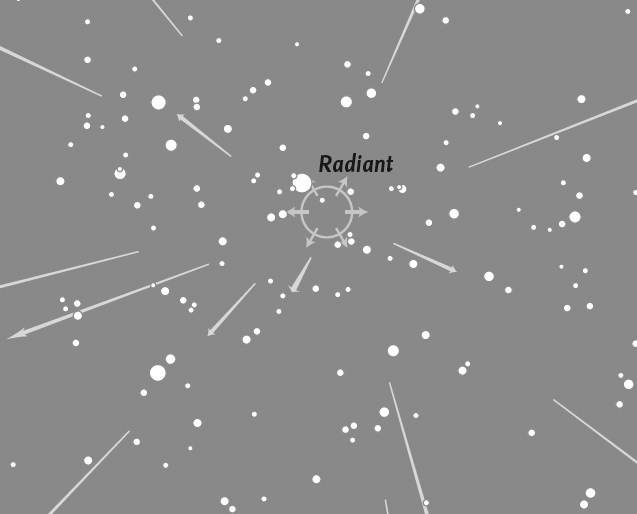
Meteor shower (showing the April Lyrid radiant).
Meteors
At some time or other, nearly everyone has seen a meteor – a ‘shooting star’ – as it flashed across the sky. The particles that cause meteors – known technically as ‘meteoroids’ – range in size from that of grain of sand (or even smaller) to the size of a pea. On any night of the year there are occasional meteors, known as sporadics, that may travel in any direction. These occur at a rate that is normally between 3 and 8 in an hour. Far more important, however, are meteor showers, which occur at fixed periods of the year, when the Earth encounters a trail of particles left behind by a comet or, very occasionally, by a minor planet (asteroid). Meteors always appear to diverge from a single point on the sky, known as the radiant, and the radiants of major showers are shown on the charts.
Meteors that come from a circular area, 8° in diameter, around the radiant are classed as belonging to the particular shower. All others that do not come from that area are sporadics (or, occasionally, from another shower that is active at the same time). A list of the major meteor showers is given on the next page. Although the positions of the various shower radiants are shown on the charts, looking directly at the radiant is not the most effective way of seeing meteors. They are most likely to be noticed if one is looking about 40–45° away from the radiant position. (This is approximately two hand-spans as shown in the diagram for measuring angles here.)
Shower Dates of activity 2021 Date of maximum 2021 Possible hourly rate Quadrantids Dec. 28 to Jan. 12 Jan. 3–4 120 α-Centaurids Jan.31 to Feb. 20 Feb. 8 6 γ-Normids Feb. 24 to Mar. 24 Mar. 14–15 6 April Lyrids Apr. 13–29 Apr. 22 18 π-Puppids Apr. 14 to Apr. 27 Apr. 23–24 var. η-Aquariids Apr. 18 to May 27 May 6 40 Piscis Austrinids Jul. 14 to Aug. 27 Jul. 28 5 α-Capricornids Jul. 2 to Aug. 14 Jul. 30 5 Southern δ-Aquariids Jul. 13 to Aug. 24 Jul. 30 < 25 Perseids Jul. 16 to Aug. 23 Aug. 12–13 150 α-Aurigids Aug. 28 to Sep. 5 Sep. 1 6 Southern Taurids Sep. 10 to Nov. 20 Oct. 10 < 5 Draconids Oct. 7–11 Oct. 8–9 var. Orionids Oct. 1 to Nov. 6 Oct. 21 25 Northern Taurids Oct. 20 to Dec. 10 Nov. 12 < 5 Leonids Nov. 5–29 Nov. 17–18 < 15 Phoenicids Nov. 22 to Dec. 9 Dec. 2 var. Puppid Velids Nov. 30 to Dec. 14 Dec. 7 10 Geminids Dec. 3–16 Dec. 14 120+ Ursids Dec. 17–26 Dec. 22–23 < 10

